2019届高考英语二轮复习 阅读理解推理判断题专练(三)观点态度类
2019-2020年高考英语二轮复习阅读理解推理判断题专练三观点态度类
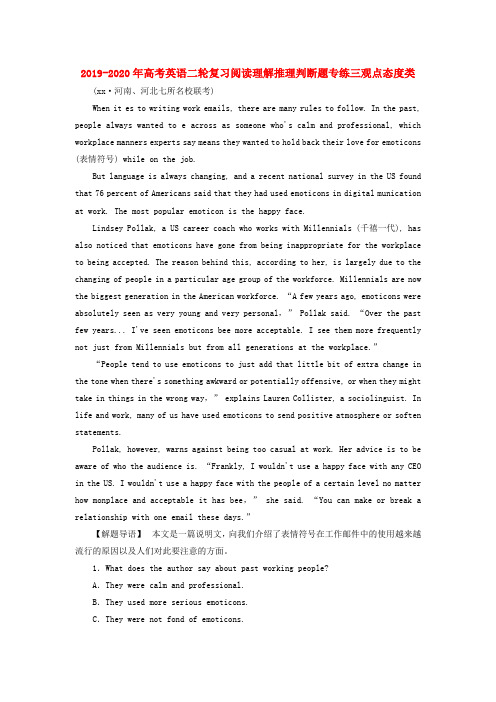
2019-2020年高考英语二轮复习阅读理解推理判断题专练三观点态度类(xx·河南、河北七所名校联考)When it es to writing work emails, there are many rules to follow. In the past, people always wanted to e across as someone who's calm and professional, which workplace manners experts say means they wanted to hold back their love for emoticons (表情符号) while on the job.But language is always changing, and a recent national survey in the US found that 76 percent of Americans said that they had used emoticons in digital munication at work. The most popular emoticon is the happy face.Lindsey Pollak, a US career coach who works with Millennials (千禧一代), has also noticed that emoticons have gone from being inappropriate for the workplace to being accepted. The reason behind this, according to her, is largely due to the changing of people in a particular age group of the workforce. Millennials are now the biggest generation in the American workforce. “A few years ago, emoticons were absolutely seen as very young and very personal,” Pollak said. “Over the past few years... I've seen emoticons bee more acceptable. I see them more frequently not just from Millennials but from all generations at the workplace.”“People tend to use emoticons to just add that little bit of extra change in the tone when there's something awkward or potentially offensive, or when they might take in things in the wrong way,” explains Lauren Collister, a sociolinguist. In life and work, many of us have used emoticons to send positive atmosphere or soften statements.Pollak, however, warns against being too casual at work. Her advice is to be aware of who the audience is. “Frankly, I wouldn't use a happy face with any CEO in the US. I wouldn't use a happy face with the people of a certain level no matter how monplace and acceptable it has bee,” she said. “You can make or break a relationship with one email these days.”【解题导语】本文是一篇说明文,向我们介绍了表情符号在工作邮件中的使用越来越流行的原因以及人们对此要注意的方面。
2019年高考英语二轮专题训练:专题三阅读理解含答案
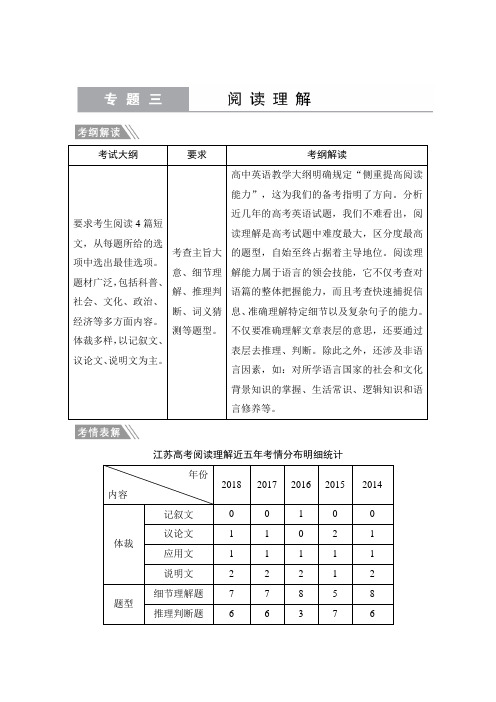
考试大纲要求考纲解读要求考生阅读4篇短文,从每题所给的选项中选出最佳选项。
题材广泛,包括科普、社会、文化、政治、经济等多方面内容。
体裁多样,以记叙文、议论文、说明文为主。
考查主旨大意、细节理解、推理判断、词义猜测等题型。
高中英语教学大纲明确规定“侧重提高阅读能力”,这为我们的备考指明了方向。
分析近几年的高考英语试题,我们不难看出,阅读理解是高考试题中难度最大,区分度最高的题型,自始至终占据着主导地位。
阅读理解能力属于语言的领会技能,它不仅考查对语篇的整体把握能力,而且考查快速捕捉信息、准确理解特定细节以及复杂句子的能力。
不仅要准确理解文章表层的意思,还要通过表层去推理、判断。
除此之外,还涉及非语言因素,如:对所学语言国家的社会和文化背景知识的掌握、生活常识、逻辑知识和语言修养等。
江苏高考阅读理解近五年考情分布明细统计年份内容2018 2017 2016 2015 2014体裁记叙文0 0 1 0 0 议论文 1 1 0 2 1 应用文 1 1 1 1 1 说明文 2 2 2 1 2题型细节理解题7 7 8 5 8推理判断题 6 6 3 7 6主旨大意题 2 0 3 2 1词义猜测题 1 2 1 1 0总结近几年江苏高考阅读理解可知,选材上更注重体现现实生活。
所选文章涉及话题广,蕴涵丰富的人文、科普知识,具有思想性、人文性、趣味性、实用性等特点和鲜明的时代特色。
文章选材丰富多样,注重考查考生在不同的语言背景下灵活运用英语语言知识分析问题和解决问题的能力。
设题方式仍以细节理解题和推理判断题为主,符合考试大纲要求,推理判断题的比重有所加大。
总体来说,语篇的难易度呈现层次性,区分度较高,高分难得,有利于高考选拔。
AThe Metropolitan Museum of Art1000 Fifth Avenue New York, NY 10028211-535-7710 EntrancesFifth Avenue at 82nd StreetHoursOpen 7 days a week.Sunday-Thursday 10:00-17:30Friday and Saturday 10:00-21:00Closed Thanksgiving Day, December 25, January 1, and the first Monday in May. Admission$25.00 recommended for adults, $12.00 recommended for students,includes the Main Building and The Cloisters(回廊) on the same day; free for children under 12 with an adult.Free with AdmissionAll special exhibitions, as well as films, lectures, guided tours,concerts,gallery talks,and family/children’s programs are free with admission.Ask about today’s activities at the Great Hall Information Desk.The Cloisters Museum and GardensThe Cloisters museum and gardens is a branch of The Metropolitan Museum of Art devoted to the art and architecture of Europe in the Middle Ages.The extensive collection consists of masterworks in sculpture, colored glass, and precious objects from Europe dating from about the 9th to the 15th century.Hours:Open 7 days a week.March-October 10:00-17:15November-February 10:00-16:45Closed Thanksgiving Day, December 25, and January 1.【语篇解读】本文是一篇应用文,介绍了纽约大都会艺术博物馆的参观须知。
2019福建高考英语二轮专项总练习学案--专项1第4讲观点态度题
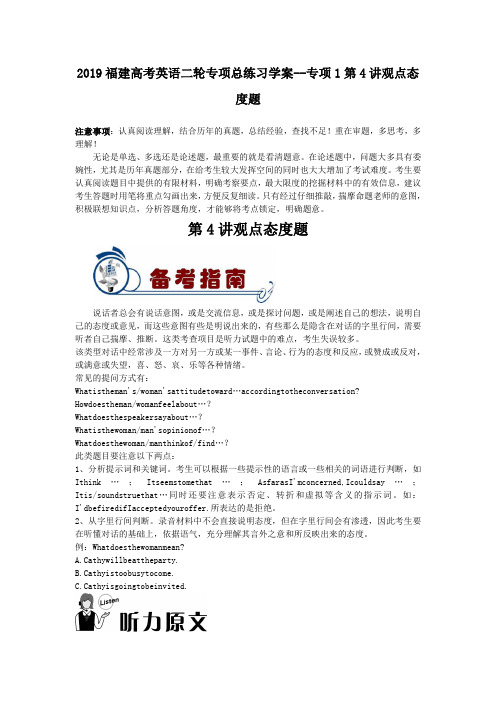
2019福建高考英语二轮专项总练习学案--专项1第4讲观点态度题注意事项:认真阅读理解,结合历年的真题,总结经验,查找不足!重在审题,多思考,多理解!无论是单选、多选还是论述题,最重要的就是看清题意。
在论述题中,问题大多具有委婉性,尤其是历年真题部分,在给考生较大发挥空间的同时也大大增加了考试难度。
考生要认真阅读题目中提供的有限材料,明确考察要点,最大限度的挖掘材料中的有效信息,建议考生答题时用笔将重点勾画出来,方便反复细读。
只有经过仔细推敲,揣摩命题老师的意图,积极联想知识点,分析答题角度,才能够将考点锁定,明确题意。
第4讲观点态度题说话者总会有说话意图,或是交流信息,或是探讨问题,或是阐述自己的想法,说明自己的态度或意见,而这些意图有些是明说出来的,有些那么是隐含在对话的字里行间,需要听者自己揣摩、推断。
这类考查项目是听力试题中的难点,考生失误较多。
该类型对话中经常涉及一方对另一方或某一事件、言论、行为的态度和反应,或赞成或反对,或满意或失望,喜、怒、哀、乐等各种情绪。
常见的提问方式有:Whatistheman's/woman'sattitudetoward…accordingtotheconversation? Howdoestheman/womanfeelabout…?Whatdoesthespeakersayabout…?Whatisthewoman/man'sopinionof…?Whatdoesthewoman/manthinkof/find…?此类题目要注意以下两点:1、分析提示词和关键词。
考生可以根据一些提示性的语言或一些相关的词语进行判断,如Ithink…;Itseemstomethat…;AsfarasI'mconcerned,Icouldsay…;Itis/soundstruethat…同时还要注意表示否定、转折和虚拟等含义的指示词。
如:I'dbefiredifIacceptedyouroffer.所表达的是拒绝。
2019高考英语二轮专题训练:专题三阅读理解含答案
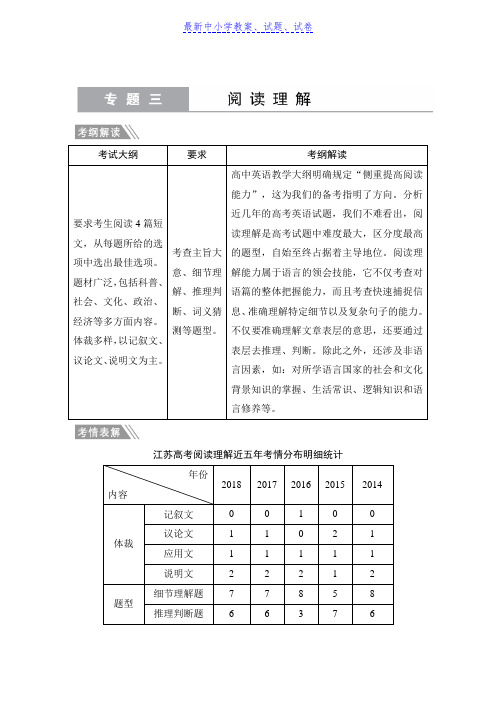
江苏高考阅读理解近五年考情分布明细统计
总结近几年江苏高考阅读理解可知,选材上更注重体现现实生活。
所选文章涉及话题广,蕴涵丰富的人文、科普知识,具有思想性、人文性、趣味性、实用性等特点和鲜明的时代特色。
文章选材丰富多样,注重考查考生在不同的语言背景下灵活运用英语语言知识分析问题和解决问题的能力。
设题方式仍以细节理解题和推理判断题为主,符合考试大纲要求,推理判断题的比重有所加大。
总体来说,语篇的难易度呈现层次性,区分度较高,高分难得,有利于高考选拔。
A。
(浙江选考)2019版高考英语大二轮复习专题一阅读理解提升练3
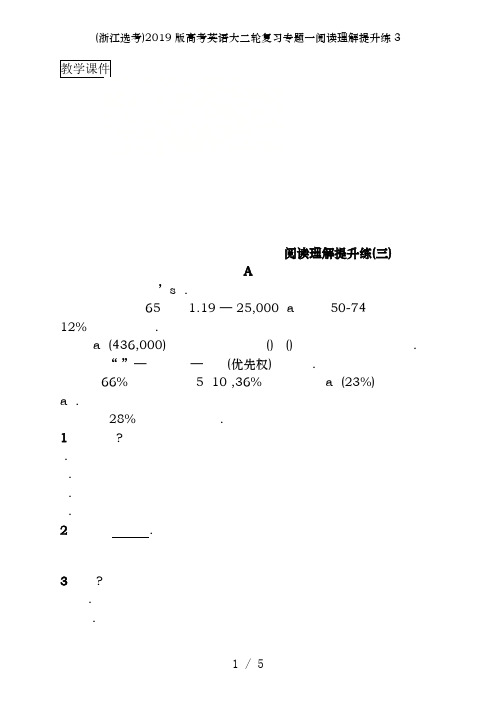
教学课件阅读理解提升练(三)A’s .65 1.19 — 25,000 a 50-74 12% .a (436,000) () () .“ ”—— (优先权) .66% 5 10 ,36% a (23%) a .28% .1 ?....2.3 ?....Ba (影棚) a “” a a .a a a “” a “ ” .a (对比) a ’s a !a “”!4 ?....5 ?....6“ ” ?....C(2018·浙江余姚中学高三押题卷一)“” (I ) I a a(轰隆隆行进) a .a a (硬草帽).I (青肿) (灾祸) ’ ,“ a ’t I .”a (倒车) ,“ a ’t ”“A ’t .” .7 ?....8 ?’s ....9 ?a a ....10’s a .a阅读理解提升练(三)A【语篇导读】本文是一篇说明文,介绍了英国雇主们所面临的员工老龄化问题以与解决措施。
1细节理解题。
根据第三段“ .”可知属于早于退休年龄离职的人。
故选C项。
2推理判断题。
根据文章最后两段可知,目前员工们得到了老板的帮助和支持,但这种现状还不是非常令人满意。
故选B项。
3主旨大意题。
根据文章第一段可知,文章主要讲述了在英国,老板们所面临的劳动力老龄化问题,以与如何向他们提供帮助来解决这一严峻问题。
故选D项。
B【语篇导读】作为群众演员,作者去影棚参与电影拍摄。
在影棚内,作者由衷地感受到了专业演员为了拍摄一部好电影,在各种各样的人造场景下所付出的艰辛。
4细节理解题。
根据文章第一段开头提到的“ a (影棚) a .”并结合下文可知,作者其实是一名群众演员。
故选C项。
5细节理解题。
根据文章第二段提到的“ a‘ ’ .”可知,是影棚中逼真的人造场景使作者感觉冷。
故选B项。
6推理判断题。
根据文章最后一段提到“ .”并结合上文可知,接下来会拍摄一个针对群演的新的场景。
故选A项。
C【语篇导读】是什么让我们对自行车情有独钟?是什么让我们对此恋恋不舍?让我们读文章了解一下吧。
2019届高考英语二轮复习阅读理解专题观点态度类型解题例举(9页,word版)

2019届二轮复习阅读理解专题观点态度类型解题例举[典例] (2018·浙江高考阅读C节选)...The problems of excessive (过度的) energy consumption, climate change and population growth have been described in a book by the American writer Thomas L.Friedman.He fears the worst, but hopes for the best.Friedman points out that the green economy (经济) is a chance to keep American strength.“The ability to design, build and export green technologies for producing clean water, clean air and healthy and abundant food is going to be the currency of power in the new century.”30.What is Friedman’s attitude towards America’s future?A.Ambiguous. B.Doubtful.C.Hopeful. D.Tolerant.[解析] 选C 根据选段第一段中的“hopes for the best”和第二段可知,Friedman虽然对未来担心,但抱有最好的希望,他认为绿色经济是使美国保持实力的一个机遇,由此可知Friedman对美国未来是充满希望的,故选C。
[干扰项分析] A项意为“模棱两可的”;B项意为“感到怀疑的”;D项意为“容忍的”。
要排除干扰项,先要弄清各干扰项的意思,是表示支持或肯定、中立还是反对或否定,然后再对照文章的内容一一排除。
高考英语二轮复习训练-阅读理解(态度推断题)
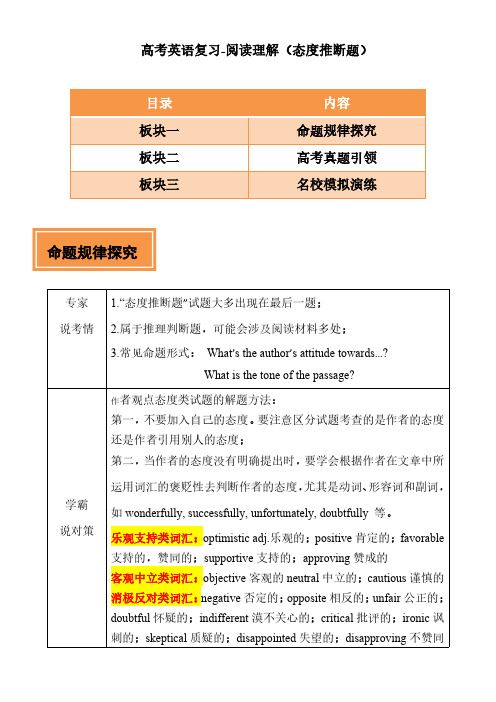
高考英语复习-阅读理解(态度推断题)命题规律探究的;pessimistic悲观的高考真题引领(2021年新高考I卷D篇,保留原题序号)Popularization has in some cases changed the original meaning of emotional(情感的)intelligence.Many people now misunderstand emotional intelligence as almost everything desirable in a person’s makeup that cannot be measured by an IQ test,such as character,motivation,confidence,mental stability,optimism and“people skills.”Research has shown that emotional skills may contribute to some of these qualities,but most of them move far beyond skill-based emotional intelligence.We prefer to describe emotional intelligence as a specific set of skills that can be used for either good or bad purposes.The ability to accurately understand how others are feeling may be used by a doctor to find how best to help her patients,while a cheater might use it to control potential victims.Being emotionally intelligent does not necessarily make one a moral person.Although popular beliefs regarding emotional intelligence run far ahead of what research can reasonably support, the overall effects of the publicity have been more beneficial than harmful.The most positive aspect of this popularization is a new and much needed emphasis(重视)on emotion by employers,educators and others interested in promoting social well-being.The popularization of emotional intelligence has helped both the public and researchers re-evaluate the functionality of emotions and how they serve people adaptively in everyday life.Although the continuing popular appeal of emotional intelligence is desirable,we hope that such attention will excite a greater interest in the scientific and scholarly study of emotion.It is our hope that in coming decades, advances in science will offer new perspectives(视角)from which to study how people manage their lives.Emotional intelligence,with its focus on both head and heart,may serve to point us in the right direction.32.What is a common misunderstanding of emotional intelligence?A.It can be measured by an IQ test.B.It helps to exercise a person's mind.C.It includes a set of emotional skills.D.It refers to a person’s positive qualities.33.Why does the author mention“doctor”and“cheater”in paragraph2?A.To explain a rule.B.To clarify a concept.C.To present a fact.D.To make a prediction.34.What is the author's attitude to the popularization of emotional intelligence?A.Favorable.B.Intolerant.C.Doubtful.D.Unclear.35.What does the last paragraph mainly talk about concerning emotional intelligence?A.Its appeal to the public.B.Expectations for future studies.C.Its practical application.D.Scientists with new perspectives.【答案】32.D33.B34.A35.B【解题导读】本文是一篇议论文。
2019年高考英语二轮专题复习训练:专题1 阅读理解 考点2 素能强化 Word版含答案
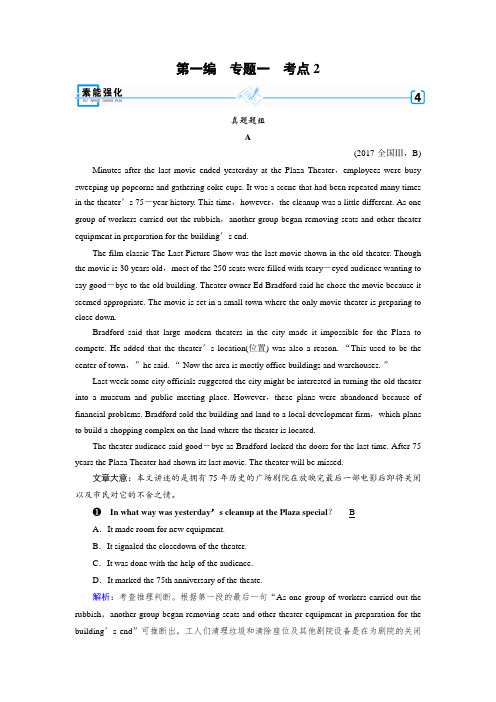
第一编专题一考点2真题题组A(2017·全国Ⅲ,B) Minutes after the last movie ended yesterday at the Plaza Theater,employees were busy sweeping up popcorns and gathering coke cups. It was a scene that had been repeated many times in the theater’s 75-year history. This time,however,the cleanup was a little different. As one group of workers carried out the rubbish,another group began removing seats and other theater equipment in preparation for the building’s end.The film classic The Last Picture Show was the last movie shown in the old theater. Though the movie is 30 years old,most of the 250 seats were filled with teary-eyed audience wanting to say good-bye to the old building. Theater owner Ed Bradford said he chose the movie because it seemed appropriate. The movie is set in a small town where the only movie theater is preparing to close down.Bradford said that large modern theaters in the city made it impossible for the Plaza to compete. He added that the theater’s location(位置) was also a reason. “This used to be the center of town,”he said. “ Now the area is mostly office buildings and warehouses. ”Last week some city officials suggested the city might be interested in turning the old theater into a museum and public meeting place. However,these plans were abandoned because of financial problems. Bradford sold the building and land to a local development firm,which plans to build a shopping complex on the land where the theater is located.The theater audience said good-bye as Bradford locked the doors for the last time. After 75 years the Plaza Theater had shown its last movie. The theater will be missed.文章大意:本文讲述的是拥有75年历史的广场剧院在放映完最后一部电影后即将关闭以及市民对它的不舍之情。
专题05阅读理解Ⅲ:推理判断题(测)2019年高考英语二轮复习含解析
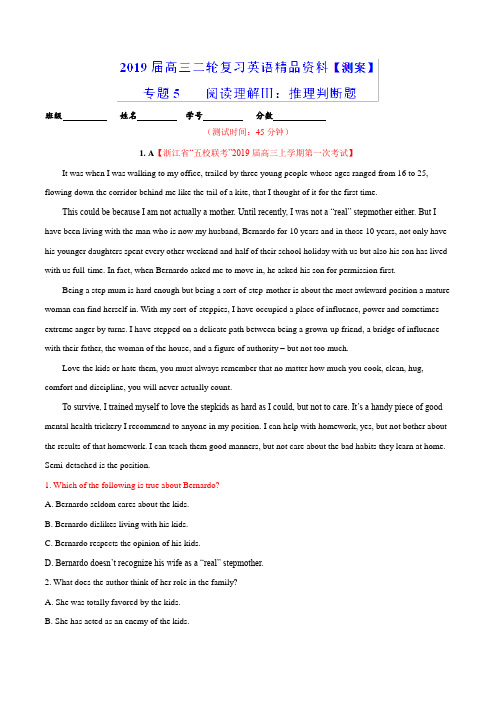
班级姓名学号分数(测试时间:45分钟)1.A【浙江省“五校联考”2019届高三上学期第一次考试】It was when I was walking to my office, trailed by three young people whose ages ranged from 16 to 25, flowing down the corridor behind me like the tail of a kite, that I thought of it for the first time.This could be because I am not actually a mother. Until recently, I was not a “real” stepmother either. But I have been living with the man who is now my husband, Bernardo for 10 years and in those 10 years, not only have his younger daughters spent every other weekend and half of their school holiday with us but also his son has lived with us full-time. In fact, when Bernardo asked me to move in, he asked his son for permission first.Being a step mum is hard enough but being a sort-of-step-mother is about the most awkward position a mature woman can find herself in. With my sort-of-steppies, I have occupied a place of influence, power and sometimes extreme anger by turns. I have stepped on a delicate path between being a grown-up friend, a bridge of influence with their father, the woman of the house, and a figure of authority – but not too much.Love the kids or hate them, you must always remember that no matter how much you cook, clean, hug, comfort and discipline, you will never actually count.To survive, I trained myself to love the stepkids as hard as I could, but not to care. It’s a handy piece of good mental health trickery I recommend to anyone in my position. I can help with homework, yes, but not bother about the results of that homework. I can teach them good manners, but not care about the bad habits they learn at home. Semi-detached is the position.1. Which of the following is true about Bernardo?A. Bernardo seldom cares about the kids.B. Bernardo dislikes living with his kids.C. Bernardo respects the opinion of his kids.D. Bernardo doesn’t recognize his wife as a “real” stepmother.2. What does the author think of her role in the family?A. She was totally favored by the kids.B. She has acted as an enemy of the kids.C. She didn’t have any influence in the family.D. She was the communication bridge between kids and their father.3. What’s the author’s advice for stepmothers in the last paragraph?A. Be partly en gaged in kids’ life.B. Care little about kids’ behavior.C. Seldom get involved in kids’ homework.D. Become the absolute authority of the family.【答案】1. C 2. D 3. A【解析】本文为应用文。
2019高考英语二轮配套课件:第三部分 阅读理解 推理判断题
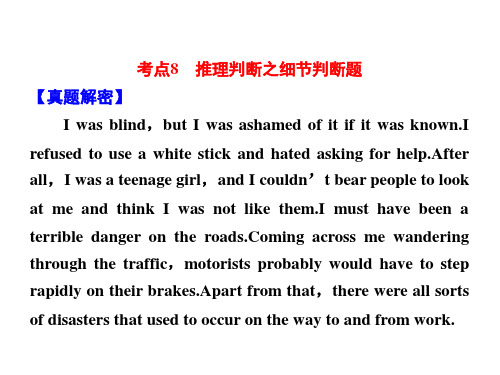
up.I decided to walk on to the next stop.
(2012·广东,C)
36.The girl refused to ask for help because she
thought____D____. A.she might be recognized B.asking for help looked silly C.she was normal and independent D.being found blind was embarrassing
考点8 推理判断之细节判断题 【真题解密】
I was blind,but I was ashamed of it if it was known.I refused to use a white stick and hated asking for help.After all,I was a teenage girl,and I couldn’t bear people to look at me and think I was not like them.I must have been a terrible danger on the ing across me wandering through the traffic,motorists probably would have to step rapidly on their brakes.Apart from that,there were all sorts of disasters that used to occur on the way to and from work.
One evening,I got off the bus about halfway home where I had to change buses,and as usual I ran into something.“I’m awfully sorry,”I said and stepped forward only to run into it again.When it happened a third time,I realized I had been apologizing to a lamppost.This was just one of the stupid things that constantly happened to me.So I carried on and found the bus stop,which was a request stop,where the bus wouldn’t stop unless passengers wanted to get on or off.No one else was there and I had to try to guess if the bus had arrived.
(江苏专用)2019高考英语二轮增分策略专题三阅读理解第二节分类突破五推理判断_观点态度题课件

28.Why is hamburger mentioned in Paragraph 2? A.To explain Americans’ love for travelling by car.
√B.To show the influence of cars on American culture.
C.To stress the popularity of fast food with Americans. D.To praise the effectiveness of America’s road system. 解析 细节理解题。根据第二段第二句“The car shaped some of the most lasting aspects of American culture...even the hamburger.”可知, 汽车塑造了某些最持久的美国文化,其中就包括汉堡。由此可知,汽车 对于汉堡文化的形成,影响是非常大的。所以,在第二段中提及汉堡, 就是为了表明汽车对于美国文化有相当大的影响。故选B项。
The cars that drove the American Dream have helped to create a global ecological disaster.In America the demand for oil has grown by 22 percent since 1990.
解析 答案
29.What has the use of cars in America led to? A.Decline of economy.
√B.Environmental problems.
C.A shortage of oil supply. D.A farm-based society. 解 析 细 节 理 解 题 。 根 据 第 四 段 第 一 句 “The cars that drove the American Dream have helped to create a global ecological disaster.”可 知,驱动美国梦的汽车导致了全球性的生态灾难,即汽车的使用引起了 环境问题。故选B项。
2019高考英语二轮:专题三 阅读理解 第三讲 含答案
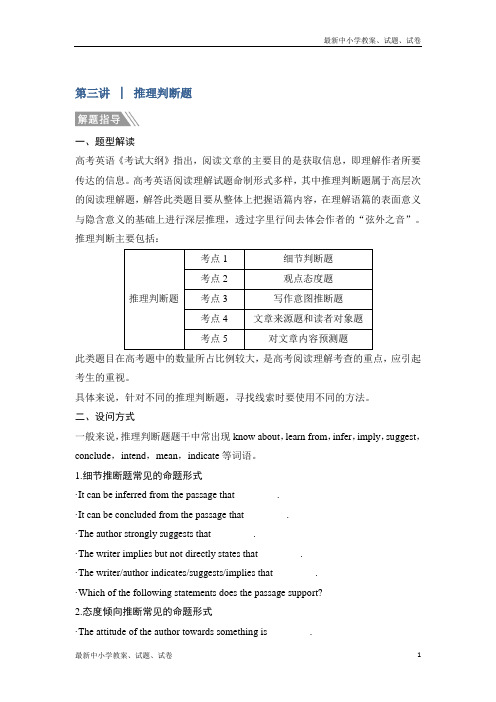
第三讲│推理判断题一、题型解读高考英语《考试大纲》指出,阅读文章的主要目的是获取信息,即理解作者所要传达的信息。
高考英语阅读理解试题命制形式多样,其中推理判断题属于高层次的阅读理解题,解答此类题目要从整体上把握语篇内容,在理解语篇的表面意义与隐含意义的基础上进行深层推理,透过字里行间去体会作者的“弦外之音”。
推理判断主要包括:此类题目在高考题中的数量所占比例较大,是高考阅读理解考查的重点,应引起考生的重视。
具体来说,针对不同的推理判断题,寻找线索时要使用不同的方法。
二、设问方式一般来说,推理判断题题干中常出现know about,learn from,infer,imply,suggest,conclude,intend,mean,indicate等词语。
1.细节推断题常见的命题形式·It can be inferred from the passage that ________.·It can be concluded from the passage that ________.·The author strongly suggests that ________.·The writer implies but not directly states that ________.·The writer/author indicates/suggests/implies that ________.·Which of the following statements does the passage support?2.态度倾向推断常见的命题形式·The attitude of the author towards something is ________.·The writer of the passage seems to think that ________.·What’s the writer’s attitude towards...?·What is the author’s opinion on...?·What does the author think about...?3.写作意图推断题常见的命题形式·What is the main purpose of the author writing the text?·The purpose of the text is to get more people to ________.·The writer of the story wants to tell us that ________.·The writer talks about...in order to ________.·The author writes the last paragraph in order to ________.4.文章来源或读者对象推断题常见的命题形式·This passage would most likely be found in ________.·In which of the following publications would this passage most likely be printed? ·The passage is probably taken out of ________.·Where does this text probably come from?·Where is the passage most likely to have been taken from?5.对文章内容预测常见的命题形式·What do you think will happen when/if...?·At the end of this passage,the writer might continue to write ________.·The paragraph following the passage will probably be about ________.·Which of the following statements is most likely to be talked about in the following paragraph?三、选项特征1.推理判断题正确选项的特征(1)“立足原文,只推一步”,即根据原文内容,一步即可推得。
【二轮冲刺】专题05 阅读理解Ⅲ:推理判断题(讲)-2019年高考英语二轮复习讲练测(精校Word版含解析)
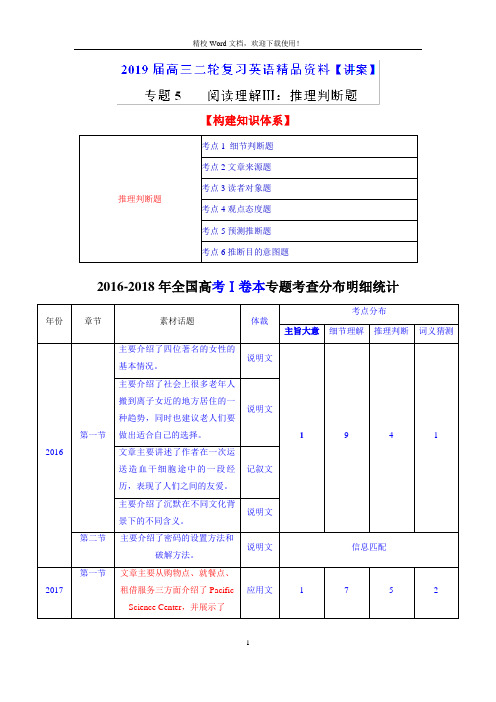
【构建知识体系】2016-2018年全国高考Ⅰ卷本专题考查分布明细统计2016-2018年全国高考Ⅱ卷本专题考查分布明细统计2016-2018年全国高考III卷本专题考查分布明细统计【考纲解读】【剖析全国高考真题】——预测高考命题方向1.C【2018·全国I】Languages have been coming and going for thousands of years, but in recent times there hasbeen less coming and a lot more going. When the world was still populated by hunter-gatherers, small, tightly knit (联系)groups developed their own patterns of speech independent of each other. Some language experts believe that 10,000 years ago, when the world had just five to ten million people, they spoke perhaps 12,000 languages between them.Soon afterwards, many of those people started settling down to become farmers, and their languages too became more settled and fewer in number. In recent centres, trade, industrialisation. the development of the nation-state and the spread of universal compulsory education. Especially globalisation and better communications in the past few decades, all have caused many Languages to disappear, and dominant languages such as English.Spanish and Chinese are increasingly taking over.At present, the world has about 6 800 languages. The distribution of these languages is hugely uneven. The general rule is that mild zones have relatively few languages. Often spoken by many people while hot. wet zones have lots, often spoken by small numbers. Europe has only around 200 Languages: the Americas about 1,000. Africa 2 400; and Asia and the Pacific perhaps 3,200, of which Papua New Guinea alone accounts for well over 800. The median number (中位数)of speakers is a mere 6.000, which means that half the worlds languages are spoken by fewer people than that.Already well over 400 of the total of, 6,800 languages are close to extinction(消亡), with only a few elderly speakers left. Pick, at random, Busuu in Cameroon (eight remaining speakers),Chiapaneco in Mexico(150). Lipan Apache in the United States(two or three)or Wadjigu in Australia (one, with a question-mark): none of these seems to have much chance of survival.28. What can we infer about languages in huntergatherer times?A. They developed very fast.B. They were large in number.C. They had similar patters.D. They were closely connected【答案】28. B【解析】本文是一篇议论文。
2019高考英语阅读理解-推理判断题(含解析)

2019高考英语阅读理解-推理判断题(含解析)一、阅读理解1.根据短文理解,选择正确答案。
Here are six steps to better studying.Pay attention in classDo you have trouble paying attention in class? Are you sitting next to a loud person? Tell your teacher or parents about any problem that is preventing you from paying attention.Take good notesWrite down facts that your teacher mentions or writes on the board. Try to use good handwriting so you can read your notes later. It's a good idea to keep your notes organized by subject.Plan ahead for tests and projectsWaiting until Thursday night to study for Friday's test will make it hard to do your best. One of the best ways to make sure that doesn't happen is to plan ahead. Write down your test dates. You can then plan how much to do after school each day, and how much time to spend on each topic.Break it upWhen there's a lot to study, it can help to break things into several parts. Let's say you have a spelling test on 20 words. Instead of thinking about all of the words at once, try breaking them down into five-word groups and work on one or two different groups each night.Ask for helpYou can't study effectively if you don't understand the material. Be sure to ask your teacher for help. If you're at home when the confusion occurs, your mom or dad might be able to help. Sleep tightSo the test is tomorrow and you've followed your study plan—but suddenly you can't remember anything! Don't panic. Your brain needs time to digest all the information you've given it. Try to get a good night's sleep and you'll be surprised by what comes back to you in the morning.(1)We know from the passage that a loud person is ________.A. a student who always answers questions loudly in classB. someone who likes to talk with others in a loud voiceC. a student who likes speaking with others in classD. a person who makes a lot of noise in public places(2)If you don't understand what you have learnt, you can ________.A. read your notes over and over againB. turn to people around you for helpC. put aside the material for later reviewD. ask your teacher to explain it the next day (3)By saying “Sleep tight”, what does the author mean?A. Sleep again after waking up.B. Sleep holding your breath deep.C. Get a good night's sleep.D. Go to sleep early every night.2.阅读下列短文,从每题所给的四个选项(A、B、C和D)中,选出最佳选项,并在答题纸上将该选项标号涂黑。
2019年高考英语二轮复习专题一阅读理解习题讲4【观点态度推理判断题】
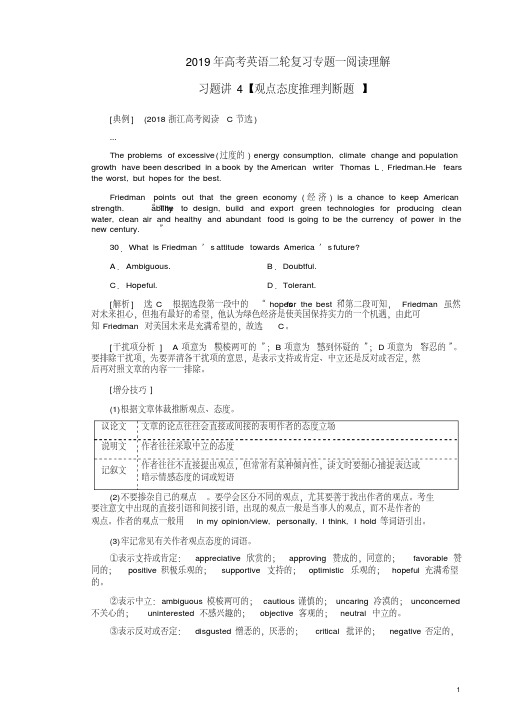
2019年高考英语二轮复习专题一阅读理解习题讲4【观点态度推理判断题】[典例](2018·浙江高考阅读C节选)...The problems of excessive(过度的)energy consumption,climate change and population growth have been described in a book by the American writer Thomas L.Friedman.He fears the worst,but hopes for the best.Friedman points out that the green economy(经济)is a chance to keep American strength.“Theability to design,build and export green technologies for producing clean water,clean air and healthy and abundant food is going to be the currency of power in the new century.”30.What is Friedman’s attitude towards America’s future?A.Ambiguous.B.Doubtful.C.Hopeful.D.Tolerant.[解析]选C根据选段第一段中的“hopes for the best”和第二段可知,Friedman虽然对未来担心,但抱有最好的希望,他认为绿色经济是使美国保持实力的一个机遇,由此可知Friedman对美国未来是充满希望的,故选C。
[干扰项分析]A项意为“模棱两可的”;B项意为“感到怀疑的”;D项意为“容忍的”。
要排除干扰项,先要弄清各干扰项的意思,是表示支持或肯定、中立还是反对或否定,然后再对照文章的内容一一排除。
2019高考英语浙江专用精准提分二轮试题:第三部分 话题拓展阅读与写作 第29节
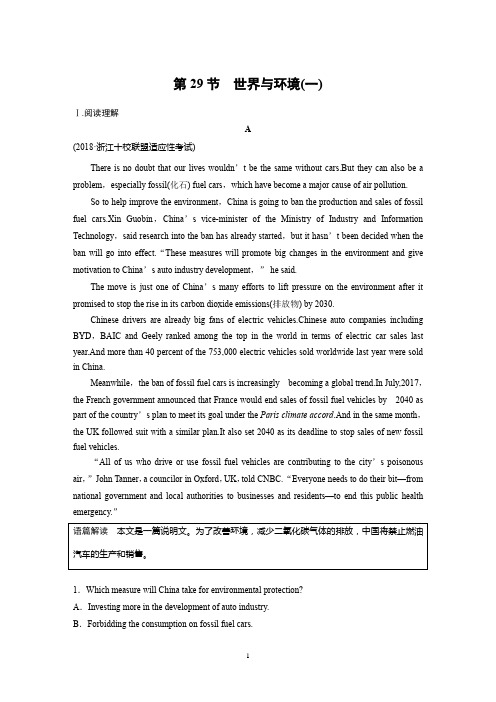
第29节世界与环境(一)Ⅰ.阅读理解A(2018·浙江十校联盟适应性考试)There is no doubt that our lives wouldn’t be the same without cars.But they can also be a problem,especially fossil(化石) fuel cars,which have become a major cause of air pollution.So to help improve the environment,China is going to ban the production and sales of fossil fuel cars.Xin Guobin,China’s vice-minister of the Ministry of Industry and Information Technology,said research into the ban has already started,but it hasn’t been decided when the ban will go into effect.“These measures will promote big changes in the environment and give motivation to China’s auto industry development,” he said.The move is just one of China’s many efforts to lift pressure on the environment after it promised to stop the rise in its carbon dioxide emissions(排放物) by 2030.Chinese drivers are already big fans of electric vehicles.Chinese auto companies including BYD,BAIC and Geely ranked among the top in the world in terms of electric car sales last year.And more than 40 percent of the 753,000 electric vehicles sold worldwide last year were sold in China.Meanwhile,the ban of fossil fuel cars is increasingly becoming a global trend.In July,2017,the French government announced that France would end sales of fossil fuel vehicles by 2040 as part of the country’s plan to meet its goal under the Paris climate accord.And in the same month,the UK followed suit with a similar plan.It also set 2040 as its deadline to stop sales of new fossil fuel vehicles.“All of us who drive or use fossil fuel vehicles are contributing to the city’s poisonous air,”John Tanner,a councilor in Oxford,UK,told CNBC.“Everyone needs to do their bit—from national government and local authorities to businesses and residents—to end this public health emergency.”1.Which measure will China take for environmental protection?A.Investing more in the development of auto industry.B.Forbidding the consumption on fossil fuel cars.C.Promoting the sales of electric vehicles.D.Developing and using green energy.答案 B解+析细节理解题。
高考英语二轮总复习课后习题 阅读理解能力升级练 考点分类练(四) 推理判断题——观点态度类 (3)
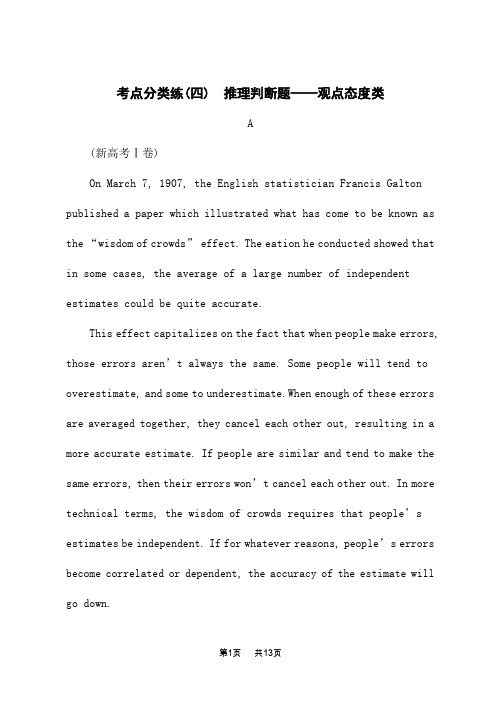
考点分类练(四) 推理判断题——观点态度类A(新高考Ⅰ卷)On March 7, 1907, the English statistician Francis Galton published a paper which illustrated what has come to be known as the “wisdom of crowds” effect.The eation he conducted showed that in some cases, the average of a large number of independent estimates could be quite accurate.This effect capitalizes on the fact that when people make errors, those errors aren’t always the same. Some people will tend to overestimate, and some to underestimate.When enough of these errors are averaged together, they cancel each other out, resulting in a more accurate estimate. If people are similar and tend to make the same errors, then their errors won’t cancel each ot her out. In more technical terms, the wisdom of crowds requires that people’s estimates be independent. If for whatever reasons, people’s errors become correlated or dependent, the accuracy of the estimate will go down.But a new study led by Joaquin Navajas offered an interesting twist(转折) on this classic phenomenon. The key finding of the study was that when crowds were further divided into smaller groups that were allowed to have a discussion, the averages from these groups were more accurate than those from an equal number of independent individuals. For instance, the average obtained from the estimates of four discussion groups of five was significantly more accurate than the average obtained from 20 independent individuals.In a follow-up study with 100 university students, the researchers tried to get a better sense of what the group members actually did in their discussion. Did they tend to go with those most confident about their estimates? Did they follow those least willing to change their minds? This happened some of the time, but it wasn’t the dominant response. Most frequently, the groups reported that they “shared arguments and reasoned together.” Somehow, these arguments and reasoning resulted in a global reduction in error. Although the studies led by Navajas havelimitations and many questions remain the potential implications for group discussion and decision-making are enormous.1.What is paragraph 2 of the teethods of estimation.B.The underlying logic of the effect.C.The causes of people’s errors.D.The design of Galton’s experiment.2.Navajas’ study found that the average accuracy could increase even if .A.the crowds were relatively smallB.there were occasional underestimatesC.individuals did not communicateD.estimates were not fully independent3.What did the follow-up study focus on?A.The size of the groups.B.The dominant members.C.The discussion process.D.The individual estimates.4.Whatistheauthor’sattitudetowardNavajas’studies?A.Unclear.B.Dismissive.C.Doubtful.D.Approving.B(山东菏泽一模)Charvi Goyal is a high school student from Dallas, Teates by tutoring them between classes. A tutor is someone who teaches one person or a very small group of students.When Goyal’s high school moved online because of the pandemic, she decided to take her teaching online. The junior and three of her fellow students created TutorScope, a programme that offers free tutoring services to other children, including younger ones. It started with a small number of tutors who helped young people in their city. But it has grown into a group of 22 tutors from Texas, Arizona and Ohio. They have helped more than 300 students.TutorScope aims to give the one-on-one help that teachers have traditionally given while walking around their classrooms. But now,many teachers cannot provide that one-on-one support because they lack time or have issues with technology.Sarah Newman said her children, 7-year-old twins, had helpful TutorScope experiences.“With these tutors, I realise they have time,” she said, “I think they are very patient with these younger kids, which I do not even have as a mother. I have patience for other things, but I don’t have patience for teaching.”What makes the TutorScope effort special is the connection between the teenage volunteers and the other students they are helping. Although the pandemic has forced many students to look inward, Goyal said that working with others on a big project had permitted her to look outward.“My confidence level has increased,” Goyal said. She added that she has made friends with other students from her school. She said one of the best things about running a growing non-profit programme is that it does help with the boredom of being stuck at home.5.What did Goyal do because of the pandemic?A.She helped her classmates at school.B.She got active in fighting a disease.C.She offered online classes to students.D.She went to another country for help.6.What’s the purpose of TutorScope?A.To give online help.B.To make profits.C.To make friends.D.To choose volunteers.7.What’sSarahNewman’sattitudetowardstheprogramme?A.Favourable.B.Tolerant.C.Skeptical.D.Critical.8.What can we learn from Goyal’s success?A.Putting the cart before the horse.B.A friend in need is a friend indeed.C.No man can do two things at once.D.Helping others will benefit oneself.COnline education has grown fast over the past ten years. The eade teaching outside the traditional classroom possible for teachers and has provided learners with easy access to course materials.In April, , I was approached by a student who was interested in our doctoral programme. However, the first question out of her mouth was,“Do you offer any online courses?” Later that day, as I was reading the conference programme guide and trying for interesting presentations, I noticed many workshops on web-based learning and online education. I later attended two of those workshops and met several professors from different universities who had either taught online courses for quite some time or who were discovering the best practice for teaching online. These ee realise at least to some extent the degree of growth in online education.I made several attempts to enrich my knowledge of distance learning and online teaching. I consulted with my colleagues who were teaching online courses. This helped me recognise the importance of getting materials prepared even before the start ofa term. I also learned that online courses may consume more time than regular classroom teaching. And I attended several workshops regarding online education and established a network with those who were involved in online programmes at other universities. I will consider these people as my consultants as I begin to design my own online course. Also, I conducted a brief survey with 15 students and two staff members who had taken or taught an online course before to understand their epleted a literature review which gave me the foundation and the background of understanding the need for online education.9.Why did the author take a student for example?A.To show students’ love for the doctoral programme.B.To persuade learners of traditional education.C.To explain the growing trend of online education.D.To predict the future of the teaching career.10.What caused the author to know more about online education?A.The appetite for knowledge.B.The professional responsibilities.C.The requirement of research.D.The colleagues’ encouragement.11.Whatistheauthor’sattitudetoonlineeducation?A.Carefree.B.Doubtful.C.Supportive.D.Unwilling.考点分类练(四) 推理判断题——观点态度类【语篇导读】本文是一篇说明文。
- 1、下载文档前请自行甄别文档内容的完整性,平台不提供额外的编辑、内容补充、找答案等附加服务。
- 2、"仅部分预览"的文档,不可在线预览部分如存在完整性等问题,可反馈申请退款(可完整预览的文档不适用该条件!)。
- 3、如文档侵犯您的权益,请联系客服反馈,我们会尽快为您处理(人工客服工作时间:9:00-18:30)。
2019届高考英语二轮复习阅读理解推理判断题专练(三)观点态度类(2017·河南、河北七所名校联考)When it comes to writing work emails, there are many rules to follow. In the past, people always wanted to come across as someone who's calm and professional, which workplace manners experts say means they wanted to hold back their love for emoticons (表情符号) while on the job.But language is always changing, and a recent national survey in the US found that 76 percent of Americans said that they had used emoticons in digital communication at work. The most popular emoticon is the happy face.Lindsey Pollak, a US career coach who works with Millennials (千禧一代), has also noticed that emoticons have gone from being inappropriate for the workplace to being accepted. The reason behind this, according to her, is largely due to the changing of people in a particular age group of the workforce. Millennials are now the biggest generation in the American workforce. “A few years ago, emoticons were absolutely seen as very young and very personal,” Pollak said. “Over the past few years... I've seen emoticons become more acceptable. I see them more frequently not just from Millennials but from all generations at the workplace.”“People tend to use emoticons to just add that little bit of extra change in the tone when there's something awkward or potentially offensive, or when they might take in things in the wrong way,” explains Lauren Collister, a sociolinguist. In life and work, many of us have used emoticons to send positive atmosphere or soften statements.Pollak, however, warns against being too casual at work. Her advice is to be aware of who the audience is. “Frankly, I wouldn't use a happy face with any CEO in the US. I wouldn't use a happy face with the people of a certain level no matter how commonplace and acceptable it has become,” she said. “You can make or break a relationship with one email these days.”【解题导语】本文是一篇说明文,向我们介绍了表情符号在工作邮件中的使用越来越流行的原因以及人们对此要注意的方面。
1.What does the author say about past working people?A.They were calm and professional.B.They used more serious emoticons.C.They were not fond of emoticons.D.They avoided using emoticons at the workplace.解析:D 考查细节理解。
根据第一段中的“they wanted to hold back their love for emoticons (表情符号) while on the job”可知,以前的职员在工作中抑制自己对表情符号的喜爱,即避免使用表情符号。
故选D。
根据第一段中的“people al ways wanted to come across as someone who's calm and professional”可排除A项。
2.What can people use emoticons to do at the workplace?A.Make it personal to communicate.B.Keep up with the trend of the times.C.Show a positive attitude to the receiver.D.Help them share their ideas and feelings.解析:C 考查推理判断。
根据第四段的内容可知,当尴尬或者可能冒犯别人的事情发生时,或者可能误解了某事时,人们往往会使用表情符号来稍微改变一下语气,传达积极的交流氛围或者让表达变得缓和。
也就是说,在工作场合,人们可以通过表情符号来向接收者表达自己积极的态度。
故选C。
3.What can we learn from the last paragraph?A.Emoticons should be used with caution.B.There are strict limitations on emoticon using.C.All the US CEOs are against the use of emoticons.D.Emoticons can greatly help bring people close.解析:A 考查推理判断。
根据最后一段中的“Pollak, however, warns against being too casual at work”“I wouldn't use a happy face w ith any CEO in the US. I wouldn't use a happy face with the people of a certain level” “You can make or break a relationship with one email these days”可知,人们在使用表情符号时要谨慎,要分场合分人,不能随意使用表情符号。
4.What's the writer's attitude towards the use of emoticons at work?A.Subjective. B.Objective.C.Doubtful. D.Opposing.解析:B 考查作者态度。
纵观全文可知,作者既谈到了表情符号的流行及作用,也谈到了人们在使用表情符号时需要注意的地方。
因此作者的态度是客观的,故选B。
B(2017·河南省第二次统一检测)Half of primary schools will adopt the traditional Chinese method of maths teaching in a Government drive to stop British youngsters from falling behindtheir_Asian_counterparts.Youngsters in the UK are way behind those in China, Singapore and Japan in numeracy (计算能力). In the latest PISA (Programme for International Student Assessment) tests for 15yearol ds, Shanghai came top in maths while the UK came 26th.The school will give up “childcentred” styles and instead return to repetition, drills and “chalk and talk” wholeclass learning. Primary school children will be taught “Shanghai maths” as British sch ools copy Chinese teaching methods to improve standards. So far 140 teachers have been trained in the approach.Currently, classes are often divided into groups based on ability. Critics blame the British teaching styles that focused on applying maths to r eallife situations in an effort to make the subject more interesting. They say this has led to confusion and stopped children learning the basics. Under the Government's new plans, children as young as five will have drills to practise sums and exercises, and must master each concept before moving to the next.Nick Gibb, the schools minister, said that training will be provided for 8 000 primary schools —half the country's total —to switch to the Shanghai “mastery” approach.“We are seeing a renaissance (复兴) in maths teaching in this country, with good ideas from around the world helping to cheer up our classrooms,” he said.【文章大意】本文是一则新闻报道。
